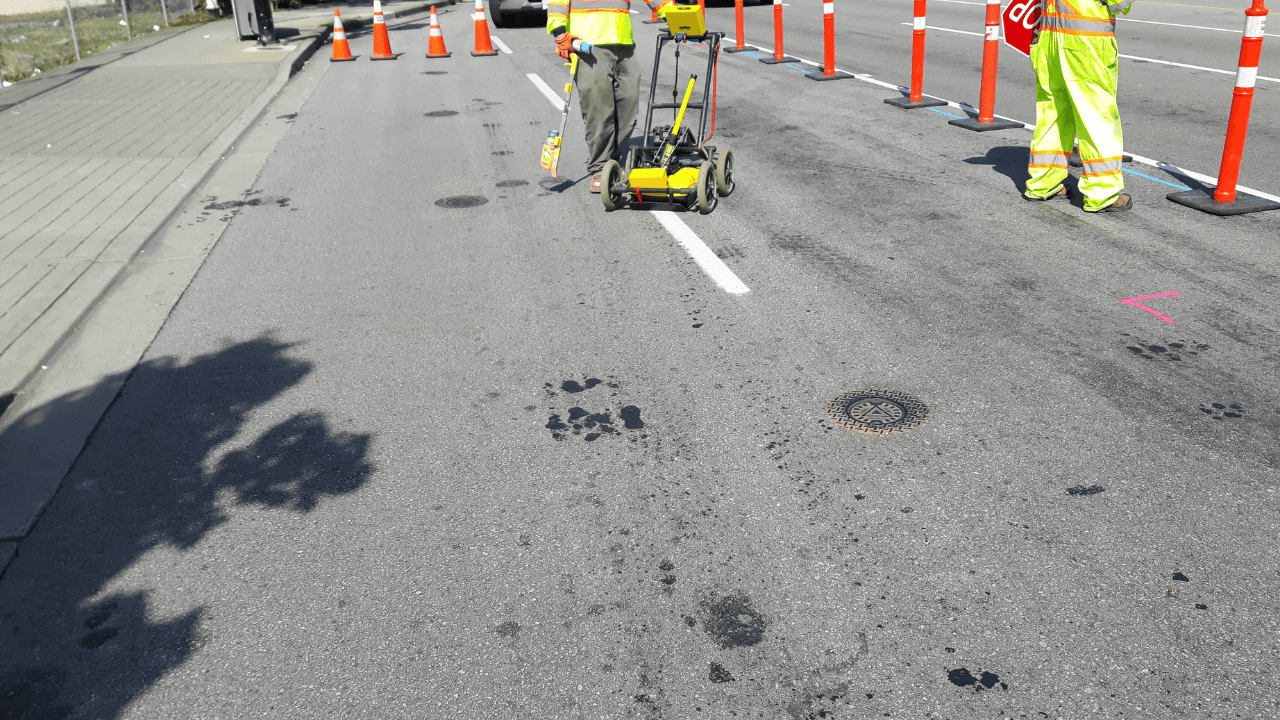Key Takeaways:
- Striking a buried gas line can lead to dangerous situations, including explosions and costly repairs. Always locate gas lines before digging.
- Professional utility locating services are critical for accurately finding underground gas and oil pipelines, especially in areas like California.
- There are multiple methods for locating gas lines, including electromagnetic locating, Ground Penetrating Radar (GPR), vacuum excavation, and marker balls.
- Professionals use specialized tools like pipe and cable locators, GPR systems, electromagnetic conductive tracers, and gas detection instruments to ensure accurate gas line detection.
- Properly locating gas lines before any construction work can prevent accidents, save money, and protect the safety of everyone involved.
Before you plan to dig or do any construction work, it’s important to know where underground gas and oil pipelines are. Striking a buried gas line can lead to severe consequences, like costly repairs or even life-threatening accidents.
This blog guides you to every detail you need to know about finding underground gas and oil supply pipelines and why utility locating is a must.
What Happens if You Hit a Buried Gas Line?
Striking a buried gas line accidentally is an unimaginable situation anyone definitely wants to avoid. If a gas line is hit, it can cause a leak, leading to dangerous gas buildup. This can result in explosions, fires, or even deadly carbon monoxide poisoning.
Beyond the safety risks, there are also hefty fines and repair costs that could come your way. Plus, damaging a gas line could disrupt service to homes or businesses in the area, causing problems not just for you, but for the whole community.
This is where utility locating services come to your rescue. Before you dig, it’s essential to know exactly where those lines are to keep everyone safe and avoid unexpected costs. If you’re in California, for example, utility locating in California is a service that can help pinpoint the exact location of these underground utilities.
Methods to Locate Gas Lines
There are multiple methods to locate underground gas and oil pipelines. Most of them involve multiple technological advancements and skilled professionals.
- Electromagnetic Locating: This is one of the most common methods. It involves sending an electromagnetic signal through the underground utility. The signal can then be detected by a receiver above ground. It’s accurate for finding metallic pipelines and is widely used by utility locators.
- Ground Penetrating Radar (GPR): GPR is another method that’s often used where electromagnetic locating isn’t possible, such as with non-metallic pipes. GPR sends radar waves into the ground, and when these waves hit a buried object, they bounce back to the detecting surface. The data is then interpreted to reveal the location and depth of the pipeline.
- Vacuum Excavation: Unlike other detecting or locating methods this method is more of a verification method. Once the relevant authorities or professional services have detected the pipeline, vacuum excavation comes in. It involves digging a small, controlled hole to visually confirm the pipeline’s location. This is often used when extreme accuracy is needed, particularly in congested areas.
- Marker Balls: Some of the modern pipelines are installed with marker balls that emit a signal detectable by specialized equipment. This method is useful for pipelines that are particularly deep or in areas where other methods might be less effective.
For a more detailed look into these methods, check out this resource on utility locating.
Tools for Locating Underground Gas Lines
Professional utility locating services and gas line locating uses a variety of tools to locate underground gas lines. Each tool is used for different situations and types of pipelines.
- Pipe and Cable Locators: These are handheld devices that can detect the electromagnetic signals emitted from underground utilities. They are versatile and are often the go-to tool for many professional utility locating services.
- GPR Systems: Ground Penetrating Radar systems are more complex but they are incredibly useful for detecting non-metallic pipes made from plastic or composite materials. GPR systems come in various sizes, from handheld devices to larger, cart-mounted units.
- Electromagnetic Conductive Tracers: These tracers are used to detect non-metallic pipes by an electromagnetic locator. They work by placing a conductive wire along or inside the pipeline, allowing it to be found using standard electromagnetic locating tools.
- Gas Detection Instruments: In cases where a gas leak is suspected, gas detection instruments can sniff out the presence of gas in the soil or air. These tools are extremely useful in emergency situations where a quick response is critical.
Why is it Crucial to Locate a Gas Pipeline?
Locating gas lines before digging isn’t just a safe idea, it’s a necessity. The consequences of hitting a gas line can be severe, both in terms of safety and costs. Taking the time to use utility location services can save you a lot of trouble down the line.
Accidents like the Murrieta explosion could have been prevented with proper locating services.
Protect Your Project: Locating Underground Gas Lines with Util-Locate!
Whether you’re planning a residential DIY project or a contractor working on a larger scale construction site, knowing the location of underground gas lines is critical. Using the right methods and tools can help us avoid accidents, save money, and ensure the safety of everyone involved.
Remember, when it comes to gas line locating, it’s better to be safe than sorry. For more tips and services related to utility locating, explore utility locating services in your area.
If you’re ever in doubt, reach out to Util Locate for professional assistance. We have the expertise and equipment to keep your project safe and on track.

